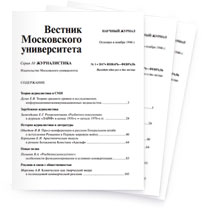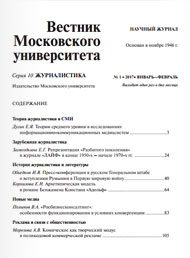Issue
Content:
-
Sociology of Journalism
«Professional Roles of Journalists of the Future: the View of Russian Educators»
The authors of the paper analyze the views of Russian journalism educators on the professional roles that journalists are to play in the future decade. The empirical data were collected as part of the global study “Journalistic Roles, Values and Competencies in the 21st Century: How Journalism Educators Across the Globe See the Future of the Profession”. The online survey was conducted under the auspices of the World Journalism Education Council (WJEC) in January-February 2021 with Russian educators from different regions of the country taking part in it as respondents. This paper focuses on the responses to two groups of questions: the reflections of educators about the typical tasks of professional journalists in the future and their view on key normative principles of neutrality and objectivity when fulfilling these professional tasks. The clustering of the ranked data makes it possible to figure out three professional roles that journalism educators expect in a ten-year term: objective disseminator, impartial investigator and social mobilizer. The authors suggest that these roles chosen by journalism educators for the careers of their students could be relevant in the future. However, they admit that this conclusion is debatable.
Keywords: journalism, journalism educators, professional tasks, professional principles, journalists’ professional roles
DOI: 10.30547/vestnik.journ.1.2022.325Nico Drok, Maria M. Lukina, Andrei V. Zamkov 3 -
Modern Journalism: Subjects and Issues
«New Social Norms of the Pandemic Period: Specifics of Construction in the Russian Media Discourse»
The article is devoted to the analysis of modern Russian media discourse, which is critical in establishing new social norms during the COVID-19 pandemic, such as wearing protective masks, maintaining social distance, vaccination, and others. The aim of the study is to examine two opposing groups of discursive practices: promoting and preventing the approval of these norms. The research methodology is based on the principles of critical discourse analysis as interpreted by E.V. Chepkina. The material is the texts of Russian media for 2020–2021 indexed by the Yandex search engine and constructing the listed social norms. It is shown that the approval of new social norms during the COVID-19 pandemic is carried out through the following discursive practices: firstly, argumentation, including logical, factual, and psychological reasons (the last point acquires special relevance because medical topics involve appeals to experts’ opinions and the establishment of sanctions for violation of the relevant norms activates the use of threat arguments); secondly, the inclusion of the COVID-19 pandemic into the chronological order of discourse by constructing epidemics of the past, the overcoming of which was associated with the establishment of similar social norms (as a result, the current pandemic reality is perceived as something ordinary); and thirdly, a constant mention of new norms in media texts regardless of their topic, which demonstrates, on the one hand, the importance of the relevant norms, and on the other, their routine and legitimate nature. At the same time, the Russian media discourse involves discursive practices that prevent the adoption of new behavioral models declared by the media as normative: 1) an inclusion in the agenda of events related to criticism of new social norms and demonstration of their non-observance; 2) the use of headlines containing sensational information that contradicts the content of the text and legitimizes the anti-norm; 3) a construction of discourse characters who declare the new norms but do not set an example of complying with them.
Keywords: discourse, media discourse, discursive practice, social norm, pandemic, coronavirus, COVID-19
DOI: 10.30547/vestnik.journ.1.2022.2645Evgeny V. Kablukov 26 -
Media Economics
«Media Franchise as a Trend Setter in the Audiovisual Industry Development: A Case Study Of Highest-Grossing Films»
Convergence in the media sphere has made multiplatform production and media content distribution possible. As a result, media franchises have become widely spread. A media franchise is a project that includes a set of media content, often in the form of a series of works that develop in one or several media segments at once. A media franchise suggests licensing intellectual property to other parties to produce new content. The study is aimed at identifying the share of media franchises among the highest-grossing films, examining the structure of the world's largest media franchises and the main directions of monetization of the largest media franchises, which include film production. The author of the paper analyzed the list of all time highest grossing films, which comprises 99 American films and a Chinese one. Only five films from this list – all American ones – do not have a continuation, which means that almost all film products with the highest rates of the world box office are, in fact, media franchises. The monetization of a media franchise is largely dependent on content branding and brand promotion in the form of new media projects and licensed merchandising. The world's largest 100 media franchises, with revenues exceeding $4 billion, are all developing in the audiovisual segment as well as in several other media segments simultaneously.
Keywords: media franchise, monetization, convergence, audiovisual industry, multiplatform production, transmedia, merchandising
DOI: 10.30547/vestnik.journ.1.2022.4676Tatiana V. El-Bakri 46 -
New Media
«The Experience of Applying the Grounded Theory Strategy to the Study of Social Media Use by Deaf and Hard of Hearing People»
The application of the grounded theory research strategy to describing the use of social media by deaf and hard of hearing people is a subject of study in this article. The author describes the experience of applying grounded theory to create a conceptual model that reveals the characteristics of communication with the participation of deaf and hard of hearing people and their use of social media, and makes a number of judgments that are formulated on the basis of methodological reflection upon completion of the study. On the basis of the proposed concept, some hypothesis were formulated, and they might be tested empirically within the framework of the representative quantitative studies. The author focuses attention on the conditions and factors that could have influenced the research process, describes and summarizes the experience connected with the application of the grounded theory research strategy.
Keywords: grounded theory, research strategy, social media, communication, the deaf, the hard of hearing
DOI: 10.30547/vestnik.journ.1.2022.7795Yuliya F. Shamsutdinova 77 -
«Genre and Thematic Features of Russian Sports Blogs»
The article examines the most popular sports blogs on the social networks such as Instagram, VKontakte and YouTube. The author studied genre, format, thematic and visual features of the publications, revealed general and particular patterns of their development and presented the results of content analysis of 7374 publications from sixty blogs. The paper showed that a large number of sports blogs are specialized: mixed martial arts (MMA) are the most popular on Instagram, football is the favorite subject on VKontakte, and YouTube is keen on fitness. Thematic features of sports blogs are similar to those of specialized sports magazines while the genres that are found on sports blogs are different from the usual media genres. A specific genre adapted to the tasks of sports blogs prevails on each social network. This is the "clarification" genre on Instagram and VKontakte and the "challenge" genre on YouTube.
Keywords: blogosphere, blog, sports blog, sports, social networks, post
DOI: 10.30547/vestnik.journ.1.2022.96118Uliana Yu. Eshkinina 96 -
Media Language
«Metaphor as a Way to Shape the Linguistic World Picture in Modern Central and Regional Russian Online Media (a Case Study of Cultural Texts)»
The article is devoted to the analysis of the influence of metaphors, used in the cultural discourse of the central and regional modern Russian online media, on the formation of the linguistic world picture of the reader. Using the methods of cognitive and structural-semantic directions of investigating metaphors in a case study of the materials in Oblast 45, Kurgan and Kurgantsy, Lenta.ru and Kommersant media outlets in 2021, the authors identified in the texts the most actively used metaphorical models, in particular anthropomorphic and military metaphors. It is shown that it is anthropomorphic metaphorical models that determine the way and style of modern Russian reader’s thinking about cultural realities. Military metaphors, which are associated with successful problem solving in theatrical and cinematic life, also demonstrate a high pragmatic potential. Inefficient, but important for the characterization of cultural discourse are social metaphors (including sports), metaphors of kinship, natural and artifact metaphors. The interaction of various metaphorical models in the cultural discourse enriches media language with new meanings, emotions and assessments. At the same time, the dominance of anthropomorphic metaphorical models brings the described cultural reality closer to the reader and forms in his mind an anthropocentric linguistic world picture.
Keywords: metaphor, linguistic world picture, media language, cultural discourse, anthropomorphic metaphorical model
DOI: 10.30547/vestnik.journ.1.2022.119135Natalia A. Kataytseva, Inna V. Shchurova 119 -
«Functional and Pragmatic Characteristics of Syntactic Devices in the Genres of American and Belarusian Media Space»
It could hardly be denied that these days modern media are gaining currency as a source of information, entertainment, and knowledge about the world. For a number of reasons, media language has become high profile one: the integration of information and communication technologies (also known as technological convergence), the increase in information sharing, a more important role of dialogization as a basic feature of modern media, a substantial change in the genre system alongside a greater level of subjectivity. Today, one does not seek tenable explanations or upending of assumptions, but rather covets an opportunity for self-expression. The aim of the given paper is to elucidate the culture-specific features of rendering expressiveness in the column and blog genres of the American and Belarusian media space, thus bringing together and contrasting syntactic language means of expressiveness used in the genres under analysis in the English (that of the USA) and Russian (that of Belarus) languages. The results of linguostylistic analysis allow the author to conclude that the most frequently used stylistic devices in columns of the US media space are parallelism, enumeration, and repetition, whereas blogs are characterized by enumeration, insertions, questions-in-the-narrative, and imperative sentences. The former group of devices performs the function of accentuation, and the latter group – that of establishing a dialogue with readers. In the Belarusian media space, syntactic expressiveness in the genres under analysis is virtually manifested by the devices of parallelism, enumeration and detachment with the function of accentuation.
Keywords: blog, column, media space, expressiveness, syntactic and stylistic device, pragmatic function, comparative analysis
DOI: 10.30547/vestnik.journ.1.2022.136156Pavel P. Glazko 136 -
Theory of Journalism and Media
«Public Diplomacy or Public Glocalization? Rethinking Public Diplomacy in the Post-Truth Era»
Public diplomacy is the communication of state and non-state actors with foreign publics for beneficial objectives. Nowadays, in this connected world, public diplomacy activities have changed. Scholars are divided into two main groups regarding these activities: the first group rates listening as the most important dimension of public diplomacy, whereas the other group considers information management to be its main activity. The choices of both groups, however, are based on the communication period before the emergence of social media, deep mediatization, fake news and the post-truth era. Therefore, this article aims to review the hierarchical taxonomy by analysing new communication considerations. It concludes that in the post-truth era, with 4.5 billion of the world population using online platforms and with a billion messages sent every day, listening no longer serves as the main dimension of public diplomacy. Information management now serves as the main form of communication, whereas public diplomacy has become public glocalization.
Keywords: public diplomacy, fake news, social media, information management, post-truth
DOI: 10.30547/vestnik.journ.1.2022.157175Hasan Saliu 157







